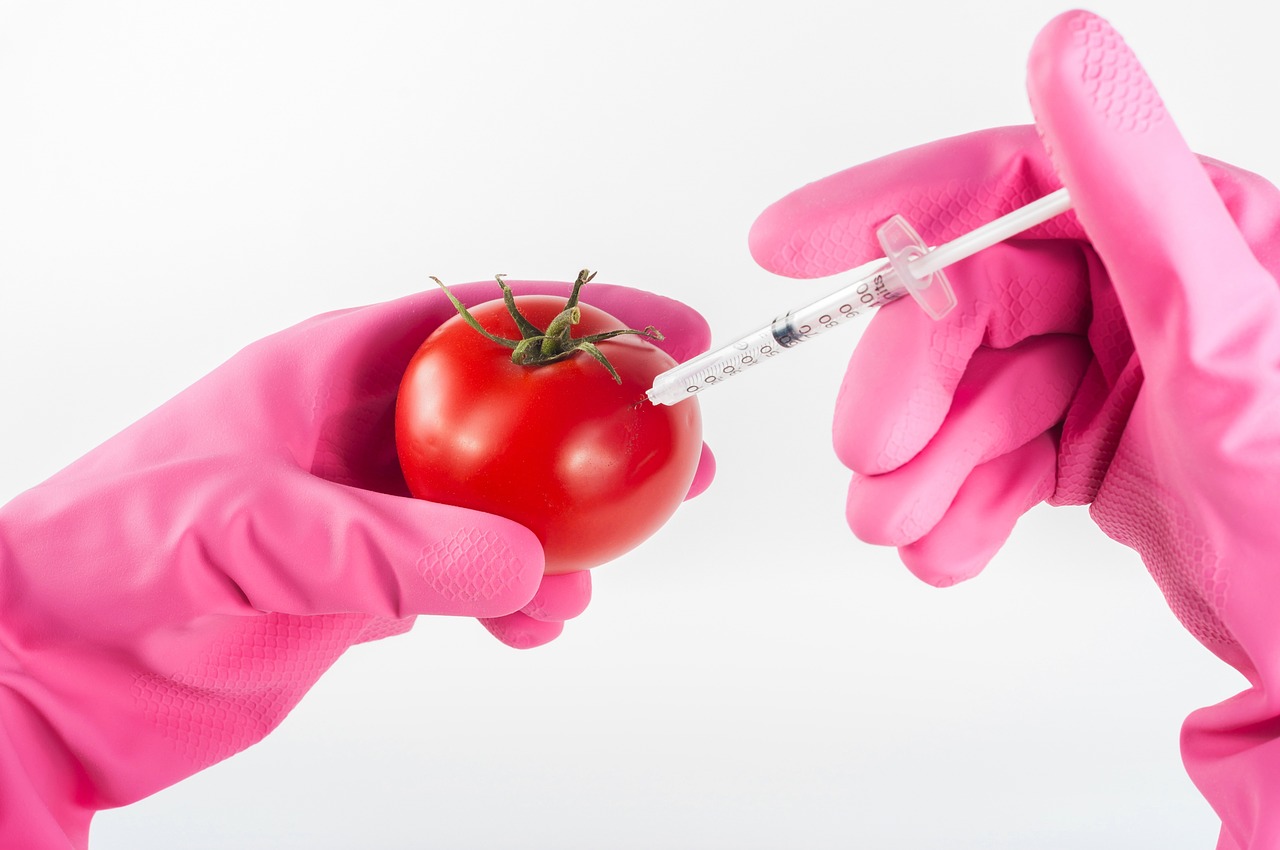Introduction
Genetically Modified Organisms (GMOs) have been a topic of debate and discussion in agriculture for decades. These organisms, whose genetic material has been altered in a way that does not occur naturally, have sparked controversies, concerns, and a fair share of misconceptions. In this article, we will delve into the world of GMOs in agriculture, separating myths from realities, and exploring the potential benefits and challenges they present to modern farming.
The ongoing debate surrounding Genetically Modified Organisms (GMOs) in agriculture has shaped the way we view and interact with our food systems. It’s a discussion that touches upon science, ethics, economics, and public perception, and it’s essential to sift through the myriad of perspectives to understand the nuanced realities of GMOs in modern farming.
GMOs, at their core, are organisms whose genetic makeup has been altered using genetic engineering techniques. This manipulation allows for the introduction of specific traits or characteristics into crops or livestock, such as resistance to pests, tolerance to herbicides, or enhanced nutritional profiles. While the genetic modifications themselves are precise and controlled, the reactions they trigger in society are anything but uniform.
One of the most prevalent misconceptions surrounding GMOs is the notion that they are inherently harmful. Critics often raise concerns about potential health risks, environmental impacts, and corporate control over seed patents. However, it’s crucial to recognize that the safety of GMOs is rigorously assessed by regulatory bodies in many countries before they reach the market. Numerous scientific studies have not found conclusive evidence of harm to human health from consuming GMOs, although ongoing research is essential to ensure their continued safety.
On the environmental front, GMOs can offer advantages. For instance, crops engineered to resist pests can reduce the need for chemical pesticides, leading to decreased environmental contamination. Similarly, herbicide-tolerant crops can allow for more efficient weed control without excessive tillage, which can lead to soil erosion and nutrient loss. These traits can contribute to more sustainable agricultural practices.
Furthermore, GMOs have shown potential in addressing global food security challenges. They can be engineered to withstand adverse weather conditions, resist diseases, and increase crop yields. In a world with a growing population and changing climate, these traits could be instrumental in ensuring a consistent and plentiful food supply.
Nonetheless, it’s essential to acknowledge that GMOs are not a one-size-fits-all solution. Their benefits and risks can vary depending on the specific crop, trait, and local context. Additionally, concerns about corporate control and the potential for genetic contamination of non-GMO crops must be addressed through regulatory frameworks and responsible stewardship.
In the debate over GMOs in agriculture, it’s vital to strike a balance between innovation and caution. Science has a pivotal role in providing evidence-based insights, while transparency and public engagement are equally essential to ensuring that the deployment of GMOs aligns with societal values and priorities. As we navigate this complex landscape, a nuanced understanding of GMOs is paramount, enabling us to harness their potential while mitigating their risks and fostering responsible, sustainable farming practices.
If you’d like to dive deeper into this subject, there’s more to discover on this page: 10 Myths About GMOs – Alliance for Science
At its core, genetic modification involves altering an organism’s DNA to introduce specific traits or characteristics. In agriculture, this can mean enhancing crop resistance to pests, improving tolerance to adverse environmental conditions, or increasing nutritional value. GMOs have been developed for various crops, including soybeans, corn, cotton, and more.
“At its core, genetic modification represents a transformative tool that harnesses the power of science to bring about deliberate changes in an organism’s DNA, imbuing it with specific traits or characteristics that can have profound implications, especially in agriculture. Within this realm, genetic modification holds the promise of enhancing crop resilience, bolstering environmental sustainability, and advancing nutritional quality. It is a technology that has yielded genetically modified organisms (GMOs) designed to address the challenges faced by our global food supply.
In the context of agriculture, genetic modification offers a spectrum of possibilities. One of its pivotal applications is in fortifying crop resistance to pests and diseases. Through the introduction of genes that produce natural pesticides or enhance the plant’s innate defense mechanisms, GMOs can significantly reduce the need for chemical pesticides. This not only mitigates environmental harm but also lessens the health risks associated with pesticide exposure for both farmers and consumers.
Moreover, genetic modification can bestow upon crops an increased ability to endure adverse environmental conditions. Drought-resistant crops, for example, have been engineered to thrive in regions where water is scarce, bolstering food security in arid climates. Similarly, flood-tolerant varieties can withstand periods of excessive rainfall, preventing crop losses due to waterlogging. These adaptations are essential for safeguarding crop yields in the face of climate change-induced weather extremes.
Another remarkable facet of genetic modification lies in its capacity to enhance the nutritional value of crops. Biofortification, a process in which essential nutrients are incorporated into staple crops, has the potential to combat malnutrition and its associated health issues on a global scale. For instance, genetically modified rice varieties have been developed to produce higher levels of vitamin A, effectively combating vitamin A deficiency, a critical health concern in many parts of the world.
The spectrum of GMOs encompasses a wide array of crops, including soybeans, corn, cotton, and many more. Each of these genetically modified varieties addresses specific challenges, from increased pest resistance in cotton to improved nutritional content in soybeans. The collective impact of these genetically engineered crops is a testament to the transformative potential of genetic modification in shaping the future of agriculture.
Nevertheless, it’s essential to acknowledge that GMOs also raise questions and concerns about potential environmental and health risks, as well as issues related to intellectual property and the consolidation of seed markets. Thus, the deployment of genetic modification in agriculture demands careful regulation, transparency, and ongoing research to assess its long-term effects.
In conclusion, genetic modification in agriculture represents a powerful tool that has the potential to revolutionize our food systems. By enhancing crop resilience, promoting environmental sustainability, and improving nutritional value, GMOs offer a pathway to address the complex challenges of feeding a growing global population while safeguarding the planet’s resources.”
If you’d like to dive deeper into this subject, there’s more to discover on this page: Should we still worry about the safety of GMO foods? Why and why …

One of the most prevalent myths about GMOs is that they are unnatural and unsafe for consumption. In reality, humans have been modifying crops through selective breeding for thousands of years. Genetic modification is simply a more precise and targeted method. Moreover, GMOs undergo rigorous testing before entering the market to ensure their safety for both consumers and the environment.
Dispelling the misconceptions surrounding genetically modified organisms (GMOs) is essential to have an informed discussion about their role in modern agriculture. The myth that GMOs are unnatural and unsafe for consumption is deeply ingrained, but a closer look at the facts reveals a different story.
First, it’s crucial to recognize that humans have been modifying crops for generations through selective breeding. This natural form of genetic alteration involves choosing plants with desirable traits and encouraging their reproduction, gradually shaping the genetic makeup of crops. Genetic modification, as done in laboratories, is essentially an extension of this age-old practice. However, it’s more precise and targeted, allowing scientists to introduce specific genes that confer beneficial characteristics such as resistance to pests or tolerance to environmental stressors.
Furthermore, GMOs undergo extensive testing and evaluation before they ever reach the market. Regulatory bodies and independent organizations rigorously assess their safety for both consumers and the environment. These assessments consider potential risks and benefits, ensuring that GMOs meet stringent safety standards.
Additionally, GMOs have demonstrated their potential to address critical global challenges. They can enhance crop yields, reduce the need for chemical pesticides, and improve the nutritional content of staple foods. These innovations are especially significant in the face of increasing global food demand and the need to reduce the environmental impact of agriculture.
While discussions about GMOs should remain open and transparent, it’s important to base opinions on scientific evidence rather than perpetuating myths. Embracing GMOs as part of a diversified and sustainable agricultural approach can contribute to more efficient and environmentally responsible food production, ultimately benefiting both consumers and the planet.
For a comprehensive look at this subject, we invite you to read more on this dedicated page: 10 Myths About GMOs – Alliance for Science

The safety of GMOs for human consumption has been extensively studied. Scientific consensus, as supported by organizations like the World Health Organization (WHO) and the U.S. National Academy of Sciences, affirms that GMOs currently approved for sale are as safe to eat as their non-GMO counterparts. There is no credible evidence to suggest that GMOs pose significant health risks.
The safety of genetically modified organisms (GMOs) has been a subject of rigorous scrutiny and scientific investigation for decades. This comprehensive examination, bolstered by the consensus of prominent organizations and experts, underscores the fundamental conclusion that GMOs pose no significant health risks to human consumption. Let’s delve deeper into the wealth of evidence supporting this perspective:
Robust Scientific Evaluation: GMOs undergo meticulous assessment before they are approved for commercial use. This evaluation encompasses extensive laboratory testing, animal studies, and, in some cases, long-term monitoring of human consumption. The scientific rigor applied to GMO safety is unparalleled.
Global Recognition: Internationally respected organizations like the World Health Organization (WHO) and national institutions like the U.S. National Academy of Sciences have consistently affirmed the safety of GMOs. These organizations rely on comprehensive data and expert analysis to reach their conclusions.
Comparable Nutritional Value: GMOs, once approved, are cultivated to maintain nutritional equivalence with their non-GMO counterparts. Extensive research ensures that any genetic modifications do not compromise the nutritional value of the crops, thus ensuring a consistent and reliable food supply.
Allergenicity Assessment: GMO developers rigorously assess the allergenic potential of modified crops. Any allergenic proteins or compounds are identified and addressed during the development process, reducing the risk of allergenic reactions in consumers.
Human Health Record: GMOs have been a staple of the global food supply for over two decades. During this period, millions of people have consumed GMO-derived products regularly, and no credible evidence has emerged to suggest that GMOs have adverse health effects.
Consistent Regulatory Oversight: Regulatory agencies worldwide, such as the U.S. Food and Drug Administration (FDA) and the European Food Safety Authority (EFSA), continue to monitor GMOs for safety and environmental impact. Their oversight ensures that GMOs meet rigorous safety standards.
Scientific Expertise: The assessment of GMO safety draws upon the expertise of geneticists, toxicologists, nutritionists, and various other experts in relevant fields. This interdisciplinary approach ensures a comprehensive evaluation of potential risks.
Peer-Reviewed Research: Numerous peer-reviewed studies have investigated the safety of GMOs from various angles. The overwhelming consensus in the scientific community is that GMOs are no more risky than conventional crops.
Benefits of GMOs: It’s essential to recognize that GMOs have brought about significant agricultural benefits, such as increased crop yields, reduced pesticide use, and enhanced resistance to pests and diseases. These advantages contribute to global food security and sustainability.
Transparency and Labeling: Many countries have implemented labeling requirements for GMO-derived products, enhancing transparency and consumer choice. These labeling systems help inform consumers while affirming the commitment to safety.
In summary, the safety of GMOs for human consumption is grounded in extensive scientific research, international recognition, and a profound lack of credible evidence suggesting harm. As the world grapples with the complex challenges of feeding a growing population in a changing climate, GMOs stand as a vital tool for sustainable and resilient agriculture, offering safe and nutritious food options for the future.
Looking for more insights? You’ll find them right here in our extended coverage: 10 Myths About GMOs – Alliance for Science

One of the key benefits of GMOs is their potential to increase crop yields while reducing the need for chemical pesticides. For example, insect-resistant GMO crops can lower pest-related losses, leading to higher yields. Additionally, some GMOs are engineered to tolerate specific herbicides, which can make weed control more efficient and environmentally friendly.
The utilization of genetically modified organisms (GMOs) in agriculture has brought about several noteworthy advantages, with one of the most prominent being their capacity to boost crop yields while concurrently diminishing the necessity for chemical pesticides. This dual benefit not only enhances agricultural productivity but also contributes to more sustainable and environmentally friendly farming practices.
Enhanced Crop Yield: GMOs have been tailored to express specific traits that enhance their resistance to pests, diseases, and environmental stressors. For instance, insect-resistant GMO crops often incorporate genes from Bacillus thuringiensis (Bt), which produce proteins toxic to certain insect pests. By having built-in protection against these pests, these crops experience fewer losses due to insect damage. This translates into higher yields, as a larger proportion of the crop reaches maturity and is available for harvest.
Reduced Chemical Pesticide Dependency: The development of GMOs with pest resistance traits has led to a significant reduction in the need for chemical pesticides. Farmers who adopt these GMO varieties can scale back their use of chemical insecticides, which not only saves on input costs but also has environmental benefits. Fewer chemical pesticides applied to fields mean reduced chemical runoff into water bodies, decreased harm to non-target species, and lower risks of pesticide resistance developing in pest populations.
Efficient Weed Control: Another advantage of GMOs lies in their ability to tolerate specific herbicides. Herbicide-tolerant GMO crops are engineered to withstand the application of particular herbicides that would otherwise kill both weeds and crops. This tolerance allows farmers to use these herbicides to control weed infestations selectively, making weed management more efficient and precise. It also enables conservation tillage practices, which help prevent soil erosion and improve soil health.
Environmental Sustainability: The reduction in chemical pesticide use and the adoption of herbicide-tolerant GMOs contribute to more environmentally sustainable farming. With decreased pesticide runoff, there is less contamination of waterways and ecosystems. Moreover, the conservation tillage practices made possible by herbicide-tolerant GMOs promote soil health by minimizing soil disturbance and erosion, ultimately benefiting the long-term sustainability of agriculture.
Economic Benefits for Farmers: GMOs’ capacity to enhance crop yields and reduce the need for chemical inputs translates into economic benefits for farmers. Higher yields mean increased profits, and reduced pesticide expenses result in cost savings. These economic advantages can be especially crucial for small-scale farmers who operate on tight profit margins.
Global Food Security: In a world with a growing population, GMOs contribute to global food security by increasing the overall availability of food. Enhanced crop yields help meet the demand for food, especially in regions where agricultural productivity is constrained by pests and environmental factors.
It’s important to note that while GMOs offer these benefits, they also raise various ethical, environmental, and regulatory considerations that must be carefully addressed. Nonetheless, their potential to increase crop yields while reducing reliance on chemical pesticides represents a significant stride toward more sustainable, productive, and environmentally conscious agriculture.
You can also read more about this here: 10 Myths About GMOs – Alliance for Science

GMOs have the potential to reduce the environmental impact of agriculture. By using GMOs that require fewer chemical inputs, farmers can minimize the ecological footprint of their operations. Moreover, GMOs like drought-tolerant crops can help conserve water resources, a crucial consideration in an era of climate change.
Genetically Modified Organisms (GMOs) represent a frontier in agriculture with transformative potential, not just in terms of crop yields but also for environmental sustainability. Beyond reducing the environmental impact, GMOs offer a path towards a more eco-conscious and sustainable agricultural future.
One of the most compelling advantages of GMOs is their ability to slash the need for chemical inputs. Traditional farming often relies heavily on pesticides and herbicides to control pests and weeds, contributing to soil and water pollution. GMOs engineered to resist pests or tolerate herbicides can significantly reduce the amount of these chemicals used. This not only benefits the environment but also promotes the health of farmworkers and nearby communities.
Furthermore, GMOs can be tailored to address specific environmental challenges. Drought-tolerant crops are a prime example. As climate change brings about more frequent and severe droughts, these crops act as a lifeline for agriculture. By requiring less water to thrive, they help conserve this precious resource, alleviating the strain on already stressed water supplies.
GMOs also have the potential to reduce greenhouse gas emissions associated with farming. For instance, crops engineered to produce higher yields on less land can help curb deforestation, a major contributor to carbon emissions. Additionally, GMOs can enable the development of more sustainable biofuels, which could replace fossil fuels in machinery and transportation, further reducing the carbon footprint of agriculture.
Nevertheless, it’s important to proceed with caution and conduct thorough environmental assessments when introducing GMOs into farming practices. Comprehensive research and stringent regulations are essential to ensure that GMOs do not inadvertently harm ecosystems or biodiversity.
In summary, GMOs hold the promise of a more sustainable and eco-friendly agriculture. By reducing the need for chemical inputs, conserving water resources, and mitigating climate change impacts, GMOs offer a valuable tool in the quest for environmentally responsible farming practices that can feed a growing global population while safeguarding our planet.
For additional details, consider exploring the related content available here Should we still worry about the safety of GMO foods? Why and why …

While GMOs offer promising benefits, they also present challenges and concerns. Crossbreeding between GMO and non-GMO crops can occur, potentially affecting biodiversity. Additionally, the concentration of GMO patents in the hands of a few corporations has raised questions about access and control over agricultural resources.
The advent of genetically modified organisms (GMOs) has undoubtedly brought about a revolution in agriculture, offering a spectrum of potential benefits and challenges that shape the agricultural landscape. Expanding on the idea that “While GMOs offer promising benefits, they also present challenges and concerns. Crossbreeding between GMO and non-GMO crops can occur, potentially affecting biodiversity. Additionally, the concentration of GMO patents in the hands of a few corporations has raised questions about access and control over agricultural resources,” we can delve into the multifaceted aspects of GMOs:
Crop Improvement and Food Security: GMOs have the potential to significantly enhance crop traits, such as pest resistance and drought tolerance. This can contribute to increased food security by boosting crop yields and reducing losses due to pests and environmental stressors.
Environmental Concerns: The potential for crossbreeding between GMO and non-GMO crops is a critical issue. It can lead to unintended consequences, such as the transfer of transgenes to wild plant populations, potentially affecting biodiversity and the natural balance of ecosystems.
Herbicide Resistance: Some GMO crops are engineered for herbicide resistance, allowing for the widespread use of specific herbicides. Overreliance on these chemicals can lead to the development of herbicide-resistant weeds, which poses challenges for weed management.
Human Health: Concerns about the long-term health effects of consuming GMOs have been raised. While GMOs undergo rigorous safety assessments, ongoing research is essential to ensure their safety for human consumption.
Socioeconomic Issues: The concentration of GMO patents in the hands of a few large corporations has sparked debates about intellectual property rights, access to technology, and control over agricultural resources. These issues have implications for small-scale farmers and global food security.
Regulation and Labeling: The regulation of GMOs varies by country, with some nations implementing stringent approval processes and labeling requirements, while others have more lenient regulations. The lack of standardized international regulations can complicate trade and consumer choice.
Coexistence Strategies: Coexistence strategies are essential to manage the potential mixing of GMO and non-GMO crops. These strategies involve physical separation, buffer zones, and best practices to minimize cross-pollination.
Biotechnology Advancements: Ongoing advancements in biotechnology, such as gene editing techniques like CRISPR-Cas9, are reshaping the GMO landscape. These technologies offer precise and rapid genetic modifications with potential benefits and regulatory challenges.
Public Perception and Education: Public perception of GMOs varies widely. Comprehensive education and transparent communication are crucial to inform consumers and policymakers about the risks and benefits associated with GMOs.
Ethical Considerations: Ethical questions surround GMOs, including concerns about corporate control of the food supply, potential exploitation of developing nations, and the ethical implications of genetic engineering.
In conclusion, GMOs occupy a complex and evolving space within agriculture. While they hold the promise of addressing pressing global challenges, they also raise a multitude of concerns that require careful consideration, regulation, and ongoing research. Striking a balance between harnessing the benefits of GMOs and mitigating their potential risks is an ongoing challenge that necessitates collaboration among scientists, policymakers, farmers, and the public to ensure a sustainable and secure future for global agriculture.
Don’t stop here; you can continue your exploration by following this link for more details: Advancing Food Integrity Gmo Regulation Agroecolo (2022) – web …

Conclusion
The debate surrounding GMOs in agriculture is multifaceted, filled with both myths and realities. It’s crucial to base discussions and decisions on scientific evidence and a comprehensive understanding of the potential benefits and challenges GMOs offer. As technology advances and our understanding of genetics deepens, GMOs may continue to play a significant role in addressing global food security challenges and sustainability in agriculture. The key lies in responsible regulation, transparent communication, and ongoing research to ensure that GMOs are harnessed for the betterment of agriculture and society as a whole.
The debate surrounding GMOs (Genetically Modified Organisms) in agriculture is a complex tapestry woven with various threads of opinion and perception, often blurring the lines between myth and reality. In navigating this intricate landscape, it becomes abundantly clear that a foundation of scientific evidence and a comprehensive understanding of the potential advantages and challenges posed by GMOs are paramount.
GMOs represent a powerful tool in the modern agricultural toolkit. They can enhance crop resilience, increase yields, and reduce the need for chemical pesticides. These are tangible benefits that, when harnessed responsibly, can contribute to addressing the pressing issues of global food security and the sustainability of our agricultural practices.
As technology relentlessly advances and our grasp of genetics deepens, the role of GMOs in shaping the future of agriculture remains dynamic. These organisms may well hold the key to unlocking solutions to the daunting challenges we face in feeding a growing global population while conserving our natural resources.
However, the path forward hinges on several critical factors. Responsible regulation is essential to ensure that GMOs are rigorously assessed for safety, both for human consumption and the environment. Transparent communication is equally vital, enabling consumers to make informed choices about the foods they eat. Furthermore, ongoing research must be prioritized to continually monitor the long-term impacts of GMOs and refine our understanding of their effects.
In essence, the debate about GMOs is not a binary one but rather a nuanced exploration of their potential, limitations, and ethical considerations. By approaching this issue with a commitment to evidence-based decision-making, responsible governance, and open dialogue, we can harness the potential of GMOs as a valuable tool in our ongoing quest for a sustainable and food-secure future. The key lies in ensuring that GMOs are not just a technological marvel but a force for the betterment of agriculture and society as a whole, where benefits are reaped without compromising our ethical and environmental values.
For a comprehensive look at this subject, we invite you to read more on this dedicated page: Myths and Realities about Genetically Modified Food: A Risk-Benefit …
More links
For additional details, consider exploring the related content available here 10 Myths About GMOs – Alliance for Science
